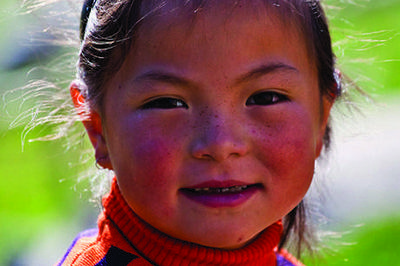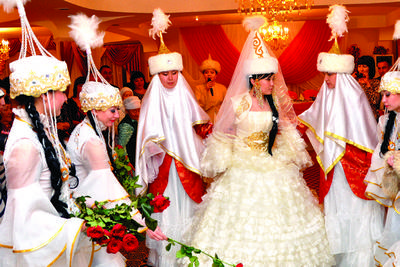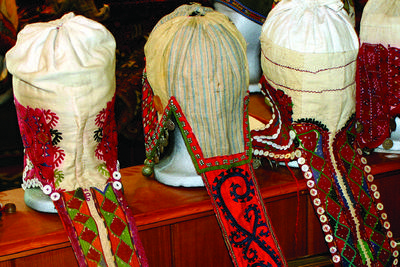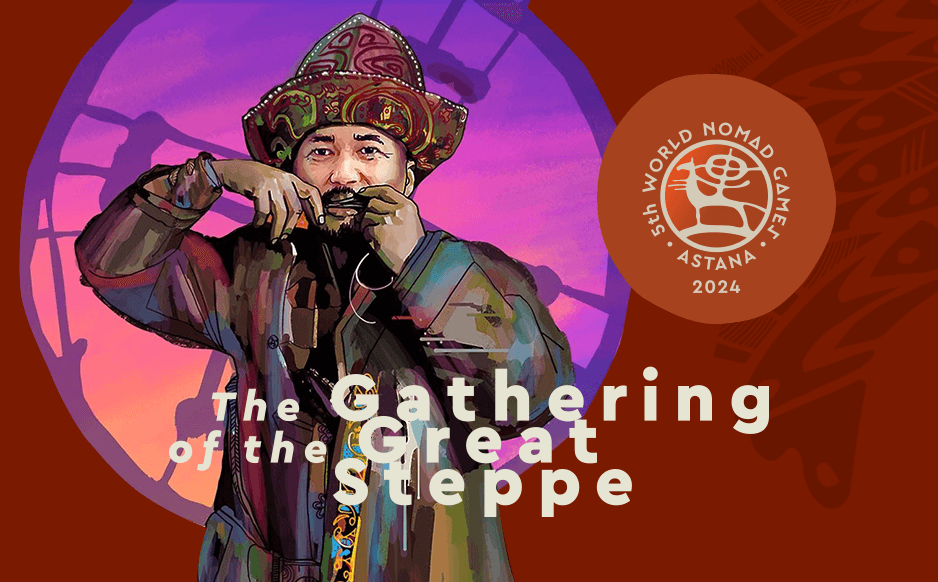Traditions
Traditions related to children
 Since childhood, children were helpers and support of their parents in life.
Since childhood, children were helpers and support of their parents in life.
If the child was naughty, parents could rename him to trick his “demons”.
So, for example, in the book “Kychan” the following is described – a Mullah, considering a child being too restless, recommended to rename him with dirty word Kychan. He said that the demons will lose sight of him, and he will be obedient.
If a child is called by the name of a great man – for example, Manas or Chyngyz, and he began to get sick, it was believed that this is due to the karma of name, which is too heavy for the child. Then parents would temporarily call him by another name until adulthood, after which the name given to him at birth would return.
When child is born a “tumar” is created. This is an amulet containing a prayer. The amulet protects its owner throughout his whole life. According to traditions, the first food of the newborn was ghee – or yellow butter, the first shirt was “um koynok” – dog shirt. It was made from scraps of white cloth, taken from very old man’s cloth, or very respected old woman’s clothes.
When child is born, there is tradition to give “suyunchu” – a gift for happy news to a messanger and “korunduk” – a gift to mother during first meeting with baby. After some time, parents organize celebrations like “Jentek Toy” or “Beshik Toy” where a number of relatives and friends arrive to bless the child and and to be involved in choosing a name. Nowadays however parents prefer to name their child themselves, or give this prerogative to their own parents. The celebrations are held just to show the baby.
When a child begins to walk, Tushoo Toy is organized. It is a celebration that features races. All invited relatives and friends race to the child, whose feet are tied with rope, and cut the rope. The rope symbolizes the obstacles that would cause him to fall. It is believed that the child after such ceremony will learn to walk and will not fall in their life path. Boys at age of three, five or seven years undergo the ceremony of circumcision. Girls at age of 10 years are given many small braids, and 2 of them stay braided behind ears for many years. After growing a little, young ladies were to begin behaving themselves modestly and observe certain etiquette.
Marriage
 Parents of the bride and groom call each other “kuda” and have a very official and respectful relationship. Nomadic Kyrgyz would perform ritual courtship as early as infancy, which is now almost never seen. So best friends could promise each other that if they will have each daughter and son, they will intermarry.
Parents of the bride and groom call each other “kuda” and have a very official and respectful relationship. Nomadic Kyrgyz would perform ritual courtship as early as infancy, which is now almost never seen. So best friends could promise each other that if they will have each daughter and son, they will intermarry.
The family of groom presents earrings to his young bride during marriage or courtship. Many perform marriage according to the Islamic principles – the mullah connects two souls under God’s supervision. The wedding is almost always something enchanting and costly.
On the groom’s arrival day to take bride away, the bride’s family arranges a wedding feast, called “Kiz uzatuu”. On the eve of this feast, the girl says goodbye to her relatives and arranges a bachelorette party. Celebration is accompanied by games, musical performances. Celebrations and moving of bride to her new village was accompanied by ritual actions.
 Before the procession of the groom, a noose is pulled that his parents have to release with small gifts. In the house of the bride another ceremony was held – special woman opened bags with gifts and bride’s relatives were given expensive clothes. The transfer of bride had its own price, called “Kalym”. Usually nomadic Kyrgyzs would give cattle. On the eve of the wedding girl relatives staged ritual of “Chach Oruu” – unwinding girlish pigtails and braiding women’s braids. Bride relatives showed the bride wearing wedding dress to groom parents – “Horde korushuu”, for which accompanying received gifts. When sending off the bride the “Kyz uzatuu” ceremony took place, which was accompanied by a loud cry and wailing of women – “Koshok aytuu”. Women were crying because the bride was becoming like a stranger to her family, a part of someone else’s family. So they followed her as if it was her last journey.
Before the procession of the groom, a noose is pulled that his parents have to release with small gifts. In the house of the bride another ceremony was held – special woman opened bags with gifts and bride’s relatives were given expensive clothes. The transfer of bride had its own price, called “Kalym”. Usually nomadic Kyrgyzs would give cattle. On the eve of the wedding girl relatives staged ritual of “Chach Oruu” – unwinding girlish pigtails and braiding women’s braids. Bride relatives showed the bride wearing wedding dress to groom parents – “Horde korushuu”, for which accompanying received gifts. When sending off the bride the “Kyz uzatuu” ceremony took place, which was accompanied by a loud cry and wailing of women – “Koshok aytuu”. Women were crying because the bride was becoming like a stranger to her family, a part of someone else’s family. So they followed her as if it was her last journey.
 Upon arrival to the groom’s place, bride was clothed with headdress – instead of “shokulo” on her head, “elechek” was put – a white turban, then dedication to fire was made – “otko kirgizuu”. An Islamic marriage took place afterwards – “Nicke kiyuu”, then the presentation of bride took place – “Kelin Coruu”, after second parents ware appointet – “Okul Ata, Okul Ene” and others.
Upon arrival to the groom’s place, bride was clothed with headdress – instead of “shokulo” on her head, “elechek” was put – a white turban, then dedication to fire was made – “otko kirgizuu”. An Islamic marriage took place afterwards – “Nicke kiyuu”, then the presentation of bride took place – “Kelin Coruu”, after second parents ware appointet – “Okul Ata, Okul Ene” and others.
After these ceremonies bride was forbidden to call husband’s relatives by names, to sit with her back turned to husband’s relatives, to sit with outstretched leg, to talk loudly, or to walk bareheaded or barefoot. It was necessary to avoid direct meetings with elder relatives of husband. According to custom bride was allowed to visit her own village “Torkulee” after one year. She could be there for a few days or months.
Her parents prepared a dowry – “Sep”, which was presented to groom’s family on the day of wedding. The dowry included everything newlyweds would need to live, from a needle and thread to livestock. Moreover, the dowry was not to be less in value than the price which was paid by groom’s family to bride’s side. Kalym and Sep still exist, though in adapted form.
Funerals
Even nowadays, when a Kyrgyz dies, a memorial yurt is put in the yard. Depending on age of the deceased there was a flag of certain color – red for the young, black for the middle-aged and white for the elderly. Only women could stay in yurt with the deceased. They sat down and cried a memorial song – koshok. Meanwhile, all the relatives clearly and timely performed their functions: someone responsible for notification, someone at the reception and the relocation, someone for cooking, etc. Full order and safety of the participants would be provided during the funeral process.
All the relatives must be involved in the funerals, no matter where they are. It was a tribute to the memory of the deceased. No reasons could be invoked to justify the absence of any of the relatives of the deceased. The main burden of expenses – “Chygym” – rested on the close relatives and neighbors, as well as spouse’s relatives – “kudalar”. Each group of participants brought with them a certain number of cattle, known as “Koshumcha”. As a result, the material situation of the family of the deceased was not adversely affected.




